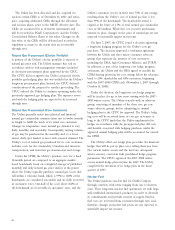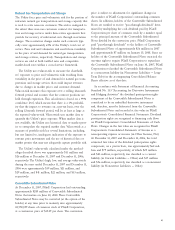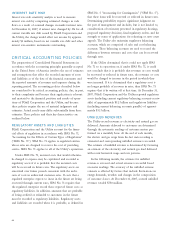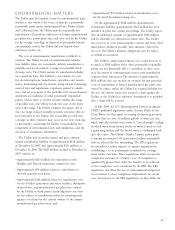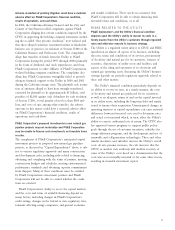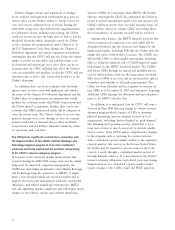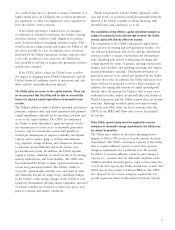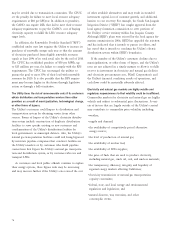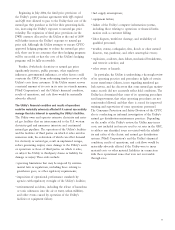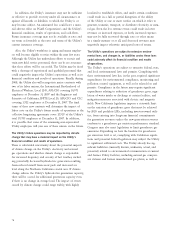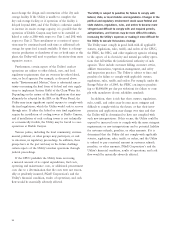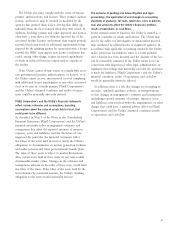PG&E 2007 Annual Report Download - page 74
Download and view the complete annual report
Please find page 74 of the 2007 PG&E annual report below. You can navigate through the pages in the report by either clicking on the pages listed below, or by using the keyword search tool below to find specific information within the annual report.72
Further, changes in laws and regulations or changes
in the political and regulatory environment may have an
adverse effect on the Utility’s ability to timely recover its
costs and earn its authorized rate of return. During the
2000–2001 energy crisis that followed the implementation
of California’s electric industry restructuring, the Utility
could not recover in rates the high prices it had to pay for
wholesale electricity, which ultimately caused the Utility
to fi le a petition for reorganization under Chapter 11 of
the U.S. Bankruptcy Code. Even though the Chapter 11
Settlement Agreement and current regulatory mechanisms
contemplate that the CPUC will give the Utility the oppor-
tunity to recover its reasonable and prudent future costs
of electricity and natural gas in its rates, there can be no
assurance that the CPUC will fi nd that all of the Utility’s
costs are reasonable and prudent, or that the CPUC will not
otherwise take or fail to take actions that would be to the
Utility’s detriment.
In addition, there can be no assurance that the bank-
ruptcy court or other courts will implement and enforce
the terms of the Chapter 11 Settlement Agreement and the
Utility’s plan of reorganization in a manner that would
produce the economic results that PG&E Corporation and
the Utility intend or anticipate. Further, there can be no
assurance that FERC-authorized tariffs will be adequate to
cover the related costs. The Utility’s failure to recover any
material amount of its costs through its rates in a timely
manner would have a material adverse effect on PG&E
Corporation’s and the Utility’s fi nancial condition, results
of operations, and cash fl ows.
The Utility faces signifi cant uncertainty in connection with
the implementation of the CAISO’s Market Redesign and
Technology Upgrade program to restructure California’s
wholesale electricity market and the potential restructuring
of the CPUC’s resource adequacy program.
In response to the electricity market manipulation that
occurred during the 2000–2001 energy crisis and the under-
lying need for improved congestion management, the
CAISO has undertaken an initiative called Market Redesign
and Technology Upgrade, referred to as MRTU, to imple-
ment a new day-ahead wholesale electricity market and to
improve electricity grid management reliability, operational
effi ciencies, and related technology infrastructure. MRTU
will add signifi cant market complexity and will require major
changes to the Utility’s systems and software interfacing
with the CAISO. It is uncertain when MRTU will become
effective. Although the CPUC has authorized the Utility to
record its related incremental capital costs and expenses, the
Utility’s ability to recover these recorded amounts from cus-
tomers will be subject to a future CPUC proceeding where
the reasonableness of amounts recorded will be reviewed.
Among other features, the MRTU initiative provides that
electric transmission congestion costs and credits will be
determined between any two locations and charged to the
market participants, including LSEs like the Utility, that take
energy that passes between those locations. The CAISO also
will provide CRRs to allow market participants, including
LSEs, to hedge the fi nancial risk of CAISO-imposed conges-
tion charges in the MRTU day-ahead market. The CAISO
will release CRRs through an annual and monthly process,
each of which includes both an allocation phase (in which
LSEs receive CRRs at no cost) and an auction phase (priced
at market, and available to all market participants). The
Utility has been allocated and has acquired via auction cer-
tain CRRs as of December 31, 2007 and anticipates acquiring
additional CRRs through the allocation and auction phases
prior to the MRTU effective date.
In addition, it is anticipated that the CPUC will issue a
decision in May 2008 that may change its current resource
adequacy program which requires all LSEs to maintain
physical generating capacity adequate to meet its load
requirements, including, but not limited to, peak demand
and planning and operating reserves, deliverable to loca-
tions and at times as may be necessary to provide reliable
electric service. If the CPUC makes comprehensive changes
to the program, such as replacing the current structure
with a centralized capacity market similar to the organized
capacity markets that operate in the Eastern United States,
the Utility may be required to procure some or all of the
capacity it needs through a centralized market instead of
through bilateral contracts. It is uncertain how the Utility’s
resource adequacy obligations and related costs may change.
Implementation of a centralized capacity market would
require changes to the CAISO tariff and FERC approval.


